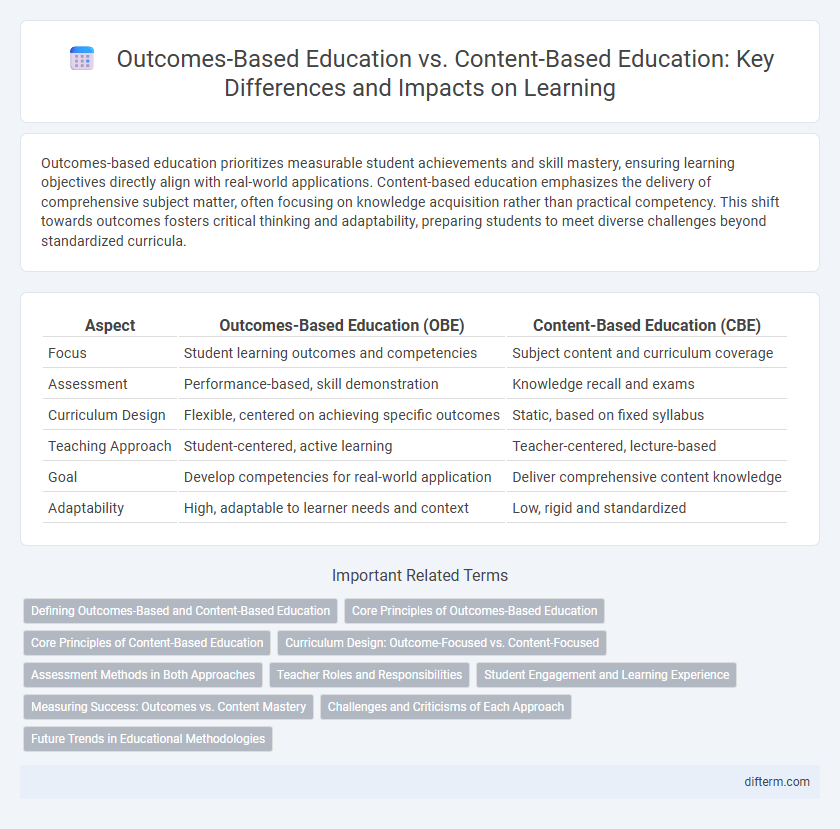Outcomes-based education prioritizes measurable student achievements and skill mastery, ensuring learning objectives directly align with real-world applications. Content-based education emphasizes the delivery of comprehensive subject matter, often focusing on knowledge acquisition rather than practical competency. This shift towards outcomes fosters critical thinking and adaptability, preparing students to meet diverse challenges beyond standardized curricula.
Table of Comparison
| Aspect | Outcomes-Based Education (OBE) | Content-Based Education (CBE) |
|---|---|---|
| Focus | Student learning outcomes and competencies | Subject content and curriculum coverage |
| Assessment | Performance-based, skill demonstration | Knowledge recall and exams |
| Curriculum Design | Flexible, centered on achieving specific outcomes | Static, based on fixed syllabus |
| Teaching Approach | Student-centered, active learning | Teacher-centered, lecture-based |
| Goal | Develop competencies for real-world application | Deliver comprehensive content knowledge |
| Adaptability | High, adaptable to learner needs and context | Low, rigid and standardized |
Defining Outcomes-Based and Content-Based Education
Outcomes-based education (OBE) centers on clearly defined learning outcomes that students must achieve, emphasizing skill mastery and real-world application. Content-based education prioritizes the delivery and coverage of subject matter, focusing on the quantity and depth of information presented in the curriculum. The key distinction lies in OBE's goal-driven approach targeting measurable competencies, while content-based education concentrates on comprehensive content coverage without explicit outcome benchmarks.
Core Principles of Outcomes-Based Education
Outcomes-Based Education (OBE) emphasizes clear, measurable learning outcomes that guide curriculum design, instruction, and assessment to ensure students achieve specific competencies. Core principles include student-centered learning, mastery of essential skills, and continuous assessment to monitor progress and provide personalized support. Unlike content-based education, which prioritizes coverage of material, OBE aligns all educational activities with demonstrable learner achievements.
Core Principles of Content-Based Education
Content-Based Education (CBE) centers on delivering subject matter through thematic units that integrate language skills and academic content, promoting deeper understanding and retention. Core principles of CBE include contextualized learning, where language acquisition occurs naturally within meaningful, real-world topics, and curriculum alignment that ensures content relevance and coherence. This approach contrasts with Outcomes-Based Education by emphasizing content mastery and cognitive development rather than predefined competencies or performance standards.
Curriculum Design: Outcome-Focused vs. Content-Focused
Outcome-focused curriculum design prioritizes clearly defined learning objectives that guide instructional strategies and assessments to ensure students achieve specific competencies. Content-focused curriculum design centers on the delivery of subject matter, emphasizing comprehensive coverage of topics without necessarily linking to measurable skills or outcomes. Integrating outcome-based principles enhances curriculum relevance by aligning educational activities with real-world applications and learner mastery.
Assessment Methods in Both Approaches
Outcomes-based education employs performance-based assessments, portfolios, and real-world tasks to measure students' abilities to apply knowledge and skills effectively. Content-based education relies heavily on standardized tests and quizzes that evaluate memorization and understanding of specific subject matter. The shift toward outcomes-based assessment emphasizes critical thinking, problem-solving, and practical application, contrasting with the traditional focus on content recall and comprehension.
Teacher Roles and Responsibilities
In outcomes-based education (OBE), teachers act as facilitators who design learning activities aligned with clear, measurable student competencies, emphasizing personalized support and continuous assessment to ensure mastery. Conversely, in content-based education, educators primarily function as knowledge transmitters responsible for delivering standardized curriculum content within fixed timeframes, with less flexibility for adaptation. The shift from content delivery to competency development demands that teachers in OBE adopt reflective practices and adjust instructional strategies based on learner progress and outcomes data.
Student Engagement and Learning Experience
Outcomes-based education emphasizes student engagement by aligning learning activities with clear, measurable goals, fostering active participation and deeper understanding. In contrast, content-based education prioritizes the delivery of subject matter, often leading to passive learning and limited student interaction. Focusing on outcomes enhances the overall learning experience by promoting critical thinking, collaboration, and real-world application of knowledge.
Measuring Success: Outcomes vs. Content Mastery
Measuring success in outcomes-based education centers on students demonstrating specific skills and competencies, ensuring real-world applicability and personalized learning progress. In contrast, content-based education evaluates success through mastery of predefined curriculum material, often relying on standardized testing to assess knowledge retention. Emphasizing outcomes encourages critical thinking and problem-solving, while content mastery prioritizes information recall and academic benchmarks.
Challenges and Criticisms of Each Approach
Outcomes-based education (OBE) faces challenges related to rigid assessment criteria that may limit creativity and critical thinking, while content-based education often struggles with relevance and adaptability to real-world skills. Critics argue OBE can lead to a narrow focus on measurable outcomes, neglecting broader educational development, whereas content-based approaches may result in rote learning and insufficient emphasis on practical application. Both methodologies require careful balancing to address diverse learner needs and evolving educational goals.
Future Trends in Educational Methodologies
Future trends in educational methodologies emphasize outcomes-based education (OBE) over traditional content-based education by prioritizing measurable skills and competencies aligned with workforce demands. Innovative assessment techniques and adaptive learning technologies support personalized learning pathways that address individual student needs and real-world applications. This shift facilitates improved student engagement, critical thinking, and lifelong learning essential for navigating evolving global challenges.
outcomes-based education vs content-based education Infographic

 difterm.com
difterm.com